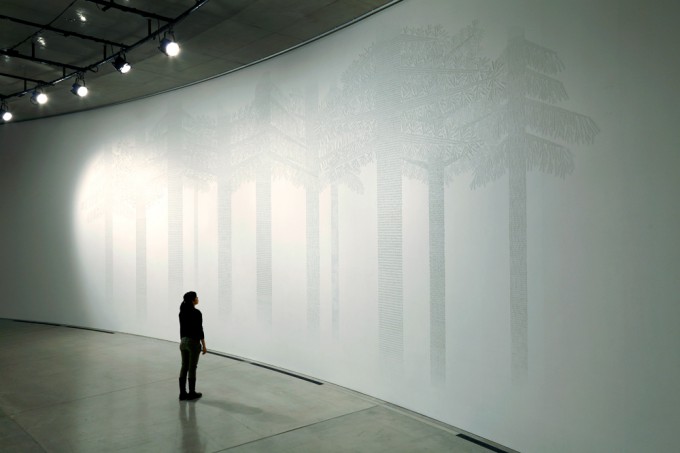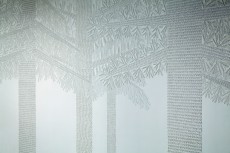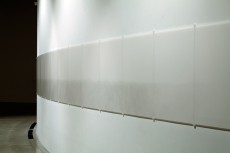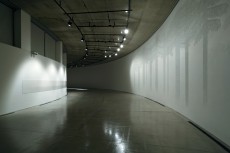
“Re-Modernologio” Phase3: Traces of Scenery
February 18 (Sun) ~ March 25 (Sun), 2012 10:00 - 18:00 / Free
SASAKI Ai

Remained forest
Ancient Memories and Shapes of Their Imprints
KONDO Yuki
Since the beginning of her career as an artist, SASAKI Ai has created huge wall paintings using a technique she calls “loyal icing” and her materials include sugar, albumen from eggs and lemon. The nature of sugar, her primary material for this technique, reveals the nature of her work: she paints on walls under the theme of “memory” as she strives to generate a kind of “space” through painting.
Loyal icing refers to the technique of decorating and transforming something to make it special. The materials are not expected nor supposed to be permanent and the finished work is equal to the sum total of her actions that were devoted to the limited time of an exhibition. These decorations, which use only the ordinary materials of daily life, are neither aimed at being preserved nor need typical painting materials such as coloring and pigment. They remind us of decorations we often see at scenes of rituals, for example, patterns on women’s skins painted on special occasions or different designs painted using condiments and butter on temple walls during Hindu ceremonies. These customs tell us about the origin of decorations, and Sasaki associates such ceremonial decorations with her loyal icing wall paintings that are installed for the specific period of an exhibition.
As for the sugar, the main material in loyal icing, it is a familiar food additive used for sweetening foods and also a preservative to prevent foods from going bad. In contrast to salt, which is a similarly colored seasoning that contains symbolic meaning regarding the boundaries between holiness and the world or life and death in Japan, sugar is associated with fascinating pleasures and daily delights in terms of “sweetness” and “scent”. Then again it is a known chemical that operates powerfully on the brain and frequently becomes addictive. This nature of sugar is also associated with the theme of her work, “memory,” and its preservation. In this way, the meaning of the material overlaps with the ambiguity of the meaning of time: the physically short life of a wall painting produced in order to create “space” in the given time versus the symbolic eternity of the shapes which have been passed from generation to generation in order to convey ancient memories. In addition, the two are connected through the action of “decoration.”
Under the theme “memory,” Sasaki has so far painted abstract forms and patterns using universal and mythical motifs such as mountains, ships and houses. These images include imprints of memories that emotionally impacted our ancestors, and also shapes that bring to the present ancient experiences that otherwise would have been lost. In addition to these motifs, she has recently started painting trees and plants and is currently using these images extensively. During her experiences at various artist residencies throughout the world, she researched the myths, folk tales, traditional patterns, landscapes and vegetation of these regions as a way of understanding each locality so as to translate this research into her work. Through the research, Sasaki, who had intended to create “space” through her work, came to try to understand what she cannot do anywhere else except at that place: adapt herself to the locality and create and deepen a relationship with it. It was in 2008 during her residencies in New Zealand and Australia, which contain quite different history, vegetation and topographies from those of Japan, that she started painting such trees and plants. She paints trees with motifs of the actual botanical species growing in the locality thereby retaining the identity of each species even though they are arranged in patterns, in comparison with the abstract motifs without any identity that she had painted up until that time. Since then trees and plants have appeared as motifs on her wall paintings, and she says that the degree of abstraction and symbolism diminished when painting trees and forests as compared to the former motifs[1]. Trees have always been regarded as individuals with wholeness as they grow while transforming their shapes regardless of species and botanical characteristics, and thus, since ancient times, people have believed that there is something in seeing trees that has relevance, in realizing the wholeness of life or the world. It is this wholeness that people cannot always grasp and can only imagine. The nature of trees, in that the individuality is equal to the wholeness, and vice versa, may enable her to paint individual shapes.
For Remained forest, part of this exhibition, she chose a specific group of trees, that is, the trees buried during the last glacial period, as a motif for the wall painting. During this period, approximately between 80,000 to 20,000 years ago, these trees became submerged and buried into a deposit of peat, due to the drastic environmental changes taking place in the extremely cold season during the second half of the last glacial period. There exists, along a kilometer along the seashore of Dekishima in Tsugaru city, Aomori prefecture, a few thousands trees, including 28,000-year-old conifers, that crop out due to the impact of diastrophism. The fossilized trees are remnants of the previous earth with boundaries between the sea and the land, different from the present, and they tell us of time flowing on a large scale, like that of the movement of the earth’s crust. Though we can only partially understand, with the limited knowledge we have in one short lifetime, these kinds of huge changes occurring in the grand sweep of time concerning nature, nonetheless these changes can have a strong impact differently on the work and characteristics of the local people for a long time. From these small imprints of time we get a glimpse of eras we cannot experience and also perceive the unseen power behind us.
Eleven trees on the 6-meter-high white wall were created using the technique of loyal icing and were done in a very formal and decorative manner, recreating some specific species of trees buried during the last glacial period, such as the Japanese red pine, the Yezo spruce and the Picea. Each trunk is covered with a different geometrical pattern, and the branches stretching up and down symmetrically are densely filled with patterns of leaves. The strength and weakness of the painted lines, arising from a difference in thickness of the materials, along with the arrangement of the trunks, gives a strong sense of depth within the scene, so that the trees seem to follow one another in succession into the white background. Equally, both the upper and lower parts of the trunks get thinner towards the ends, helping the presence of the trees melt into the white background. Consequently, the actual wall, that is, the substance of the background, is transformed into an immaterial space spreading in all directions. The effect of these specific motifs are strong: with the extreme planarity and patterning of individual motifs, with the depth of the whole panorama, the gradual disappearance of the upper and lower parts, and the white tone on the white background, the forest becomes silhouetted as if in a dream. It is the lost forest leaving only fossils and also looks like an ancient dream of the earth.
The decorations can give some value to the “space” or transform it through the form, rather than by representing the identity or the expressions of the artist. The intention that a wall painting should be decorative means that the artist attempts to turn the work into images associated with our daily lives and their details, which might be regarded as a kind of orientation towards anonymity, and not as his or her free expression. But still, as for Sasaki’s symbolic images that she creates by the crystallization of her personal experiences using modern materials while she looks for imprints of ancient memories and orients herself to those shapes, there is some intention of formally representing the world in a new way. It seems that she tries to remember such vivid and emotional experiences and to find other ways of passing them from generation to generation. On the other hand, her drawings show vast and vague gray scenery as a whole but they also retain individualities in their details, revealing different consciousness. For Sasaki, drawing is as natural as breathing, and the drawings keep a kind of physicality and individuality in contrast to the large wall paintings. If the wall paintings are likened to grand stories, the drawings seem to tell a short story each. From this perspective, it can be said that both the drawings and the wall paintings met in Grayscape-Sea.
Grayscape-Sea (2007), an integral part of this exhibition, is a drawing work consisting of 19 pieces drawn on thin tracing paper in hard pencil. As shown in the title, the light gray covers over a third of the lower part of the drawings and it looks just like a gray seascape. The gradual disappearance into the white background may remind you of Remained forest mentioned above. However, as you approach the work, you can see that the vast and vague seascape is made up of a throng of innumerable trees and plants that have been finely drawn. Sasaki says that the work is derived from a strong impression she had of the forest scenery she encountered during her stay in Australia. This primeval forest consisted of eucalyptus trees, misting the air into pale blue with its strong scent that comes from the volatile sap. According to her, it looked like the blue surface of the sea. But what is drawn in the work is a different type of endless plants and trees. Situated in front of the wall painting that is composed of formalized images, the drawing suggests that each individual’s experiences and memories, or thoughts and feelings, are united into a collective memory through an archetype.
When looking at scenery, we don’t merely sense it through our sense of sight: we feel its overwhelming vastness versus our tininess and perceive it through our sense of smell, and absorb the energy of nature through our sense of touch. The experience of communing with a landscape can be taken in through different parts of our body, and sometimes we appreciate scenery empirically. Sasaki, who has intended to create a kind of “space” in an exhibition hall, synthesizes experiences that are perceived within us intuitively or by the sixth sense, when faced with such a variety of shapes in the world. She separates the shapes from the physical world, and shows them to viewers as scenery of mental images targeted at our thoughts.
While viewing the wall painting, viewers have to move around because of its large size. As for the drawing work, we are equally advised not to stop at a certain position to view the work, but to vary our distance from it, so that we can see it from multiple angles. Such movement creates an experience of appreciation, arousing our physical senses and feelings within that space. It is just like when we stroll around the forest of memory.
References
Ohara school of Ikebana. (2011). 'Forests of Contemporary Arts: Expression of Forests Spreading Beyond “Seeing” - SASAKI Ai' in Ohara-ryu soka, vol.733,
[1] Interview with the artist for AC2, vol.13, regular publication by Aomori Contemporary Art Centre.

Remained forest, detail

Grayscape-Sea

Remained forest
「再考現学 / Re-Modernologio」pahse3:痕跡の風景
2012年2月18日(土)~3月25日(日) 10:00 - 18:00/無料
air2011-4ja
佐々木愛
SASAKI Ai

《Remained forest (残された森)》
伝承される記憶、痕跡の形
近藤由紀
佐々木愛は、作家としての活動当初より砂糖と卵白そしてレモンを原料とするロイヤルアイシングという技法によって巨大な壁画を描いている。そしてこの技法あるいは原料である砂糖の特質は、「記憶」をテーマに壁画を描き、描くことである種の「場」を創ろうとしていた佐々木の作品のコンセプトを示すものともなっている。
ロイヤルアイシングは基本的には飾るための技法であり、飾ることで何かを特別なものとする。それは残されないことが前提と された素材であり、完成物は、ある時間のためだけに捧げられた行為とその成果物である。こうした保存することを目的とせず、かつ絵の具や顔料といった絵を 描くための素材ではなく、日常的な素材を用いた装飾は、例えばヒンドゥー教の女性たちの皮膚の上に特別な時に描かれる文様や寺院の壁に祭祀の際に香辛料や バターで描かれる文様など儀式的な場面においてしばしばみられる装飾を思い起こさせる。それは装飾の起源を伝えるものであり、佐々木は同様にひと時だけ展 示空間におかれるロイヤルアイシングによる壁画制作をこうした非日常を形成するための装飾と重ねる。
またロイヤルアイシングの原料となる砂糖は、食品に甘味を加え、それが腐ることを防ぐ身近な食材である。同じ白い調味料でも日本では聖俗や生死の境といった意味を象徴的に与えられる塩とは違 い、どちらかといえばその「甘さ」や「香り」によってうっとりするような快楽や日常的な楽しみと結び付く一方で、化学物質としてのそれは脳に強く働きかけ、しばしば中毒性をもたらすことでも知られている。こうした砂糖の性質もまた、「記憶」とその保存という作品のテーマとつなげられている。このように素材の持つ意味は、あるひと時その「場」を作るためだけに描かれる壁画の物理的な短時間性と人々の間で受け継がれ古い記憶を伝えていく形の象徴的な永続性という時間の両義性と重ねられ、さらにその両者は「装飾」という行為によって結びつけられている。
「記憶」をテーマとしてきた佐々木の壁画で は、これまで山や船、家といった普遍的、神話的モチーフが抽象化、図案化して描かれてきた。それらは、祖先が心を動かされた記憶の痕跡であり、遠く失われてしまった古い経験を今に伝える形である。これらに加え、近年佐々木の壁画には木々や植物が登場し、多く描かれるようになっている。各地での滞在制作を経験することとなった佐々木は、制作に際しその土地を知る手段として神話や民話を調べ、古い文様を調べ、その風景や土地の植生を調べた。それは作品によって「場」を創ることを意識してきた佐々木が、そこでしかできない何かを模索し、土地との距離を縮め、その関係性を深めるためのきっかけとなった。これらの木々や植物が描かれるようになったのは、2008年に日本とは異なる大地、それにまつわる物語、そして植生を持つニュージーランド、オーストラリアでの滞在制作がきっかけになったという。描かれた木々はその土地に実際に生えている植物種がモチーフとなっており、パターン化されているとはいえ、それまで描かれていた個性がそぎ落とされ、抽象化されたモチーフに比べ、それぞれの種の個性を保持している。これ以降佐々木の壁画のモチーフには木々や植物が現れたのだが、佐々木は木や森を描くことでそれまでモチーフに対してなされていた抽象化やシンボル化が少しだけ和らいだという[1]。 一方で木はそれがいかなる種類であろうとも、どのような個性を備えていようとも、姿を変容させ成長する様から、その個のうちに全体をもっているとみなされ、それゆえに古来より木を見ることは生命の、世界の全体性を見ることに通ずると考えられてきた。そしてこの全体性は人間がつかむことができず、想像する しかできなかったものでもある。この個にして全体、全体にして個という木の性質が佐々木により個別的な形を描くことを許したのだろうか。
今回制作された≪Remained forest(残された森)≫でも、ある具体的な木々――最終氷期埋没林の木々――がその壁画のモチーフとなっている。これは最終氷期(約 80,000~20,000年前)後期の極寒期に環境の急激な変化によって木々が水没し、泥灰層に埋まったものであり、青森県つがる市の出来島海岸沿いでは、約28,000年前の針葉樹を中心に、数千本の木々が地殻変動により約1kmにわたって露出しているのがみられる。それら木の化石は、今とは異なる海 と陸の境界をもつかつての大地の名残であり、地殻の変動という大きな時間の流れを今に伝えるものである。こうした自然の巨大な時間軸の中にある変動は、 我々人間の規模では、知識としてしか認識できないが、おそらく同じように長い時間をかけてその土地の人々の作り出すモノや性質にさまざまな影響を与えるのだろう。だが我々はそうした小さな痕跡によって経験し得ない時間を思い、我々の背後にある見えない力をみることができるのだ。
高さ6mの白い壁に白いロイヤルアイシングで描かれた11本の木々は、この最終氷期埋没林でみられるアカマツ、エゾマツ、トウヒなどの木々が形式化され、装飾化されて 描かれたものである。幹はそれぞれに異なる幾何学文様で埋め尽くされ、左右対称に上下に延びる枝には、文様化された葉がびっしりと描かれている。描かれた線の強弱(素材の厚みの差)と幹の配置は場面に奥行きを与え、木々の連続が白い背景の中へと続いているようにもみえる。同様に端へ行くほど 細く薄く描かれた幹の上下部も、木々の存在感を白い背景へと溶け込ませるのを助けている。これにより背景の地の部分である現実の壁面は、上下左右あるいは 前後に広がる非物理的な空間へと姿をかえる。それらはある種具体性を帯びたモチーフではあるが、個々のモチーフの強い平面性と文様化、全景にみられる奥行き、上下の消失感、白地の上の白の色調によって森は幻想的に浮かび上がっている。それは今は化石のみを残して失われてしまった森であり、大地の見る太古の夢のようでもある。
装飾はそれ自体が作者の個性や表現をあらわすというよりは、その形式を通して何ものかの価値を賦与し、あるいは「場」を変質させる。壁画が装飾的であろうとするということは、作家の自由な表現としてではなく、作品を日常へあるいは生活の部分へと手渡そう と するものであり、ある種の匿名性への志向であろう。だが古い記憶の痕跡を求め、そうした形を志向しながらも、現代的な素材を用い、佐々木の個人的な体験や 経験が結晶化されることでもたらされた象徴的なイメージは、世界を新たな形式化によって表わそうとするものであろう。それはこうした経験を新鮮な実感のうちに取り戻し、別の伝播の道を獲得しようとするようにもみえる。これに対し全体としては茫漠とした灰色の風景を描きながらも、細部に個を宿すドローイング作品には、別の意識が認められる。佐々木は日々息をするように沢山のドローイングを描いているのだが、それらはこうした壁画作品とは対象的 に、身体的であり、個別的であり、壁画作品が大きな物語であるとすれば、ドローイングはそのうちにある小さな物語を語るかのようである。そうした意味では ≪Grayscape-Sea≫はその両方を兼ね備えているといえるのかもしれない。
同時に展示された≪Grayscape- Sea≫(2009年)は、薄いトレッシングペーパーに固い鉛筆で描かれた19点からなるドローイング作品であり、タイトル通り白い紙の下3分の1ほどの 部分が淡い灰色で埋められ、まさに灰色の海景にみえる。白い背景へぼんやりと溶け込んでいくさまは、前述の≪Remained forest≫と重なる。しかし作品に近づくと、この茫漠たる海景が細かく描き込まれた無数の木々や植物の群れからなることがわかる。この作品も佐々木がオーストラリア滞在中に出会った森の風景に対する強い印象から生まれた作品であるという。そこではユーカリの原生林がその揮発性の高い樹液によって強い芳香を放ちながら空気を青くかすませていた。それが青く海面のように見えたのだという。だがここで描かれているのは、種類の異なる無数の植物 であり木々である。形式化された図像による壁画作品の前におかれたそれは、個々の経験や記憶、あるいは思考や感覚が一つの原型の元に集団的記憶としてまと まる姿を思わせる。
我々は風景を眺めるとき、決してそれを視覚のみで捉えるわけではないだろう。その圧倒的な大きさ、そこに対峙した時に感じる自らの小ささ、嗅覚での認識、肌で感じる自然のもつエネルギー。こうしたことは身体のさまざまな部分から受け取ることであり、そして風景は時に体験的 に鑑賞される。展示空間にある種の「場」を創りだそうとする佐々木の作品で描かれるのは、世界にあるこうしたさまざまな形を目にしたときに、我々のうちに直観的/直感的に与えられる何かである。佐々木はそれらの形を物理的な現実から引き離し、思考の対象となる心的形象の風景として見る者へと再提示する。
壁画作品を鑑賞するにはその大きさのために鑑賞者は動かなければならない。ドローイング作品もその場所だけで見るのではなく、近づき遠のくことでその作品の 二つのありようをみることができる。こうした移動はその場の空気を含んだ身体的かつ感覚的な鑑賞の体験となる。それは記憶の森を歩くかのようである。
参考:「特集現代アートの森 『見ること』を超えて拡がる森の表現 佐々木愛』」、『小原流挿花』、12月号、2011年、p.20-21。

《Remained forest》部分

《Grayscape-Sea》

《Remained forest (残された森)》
